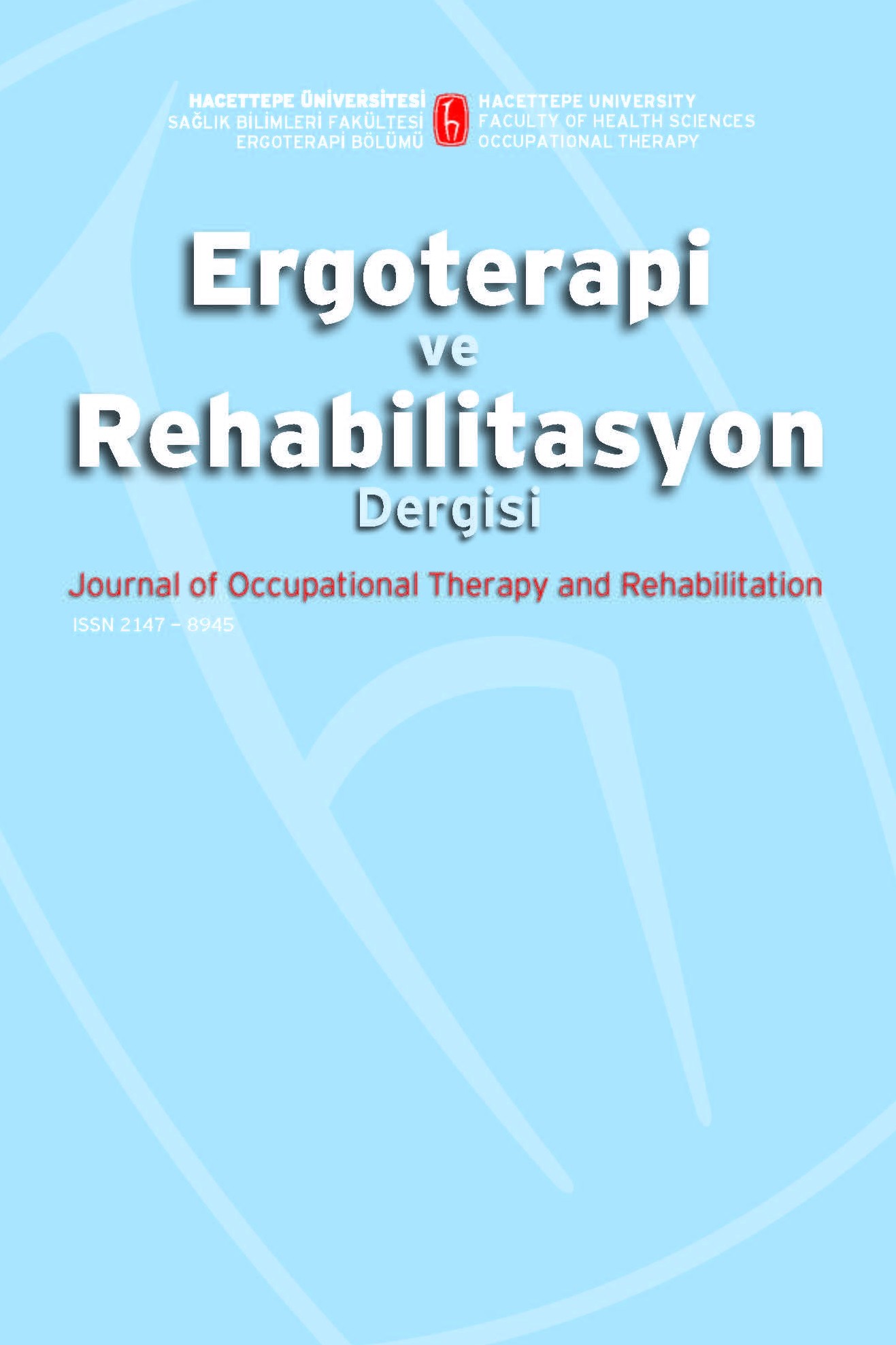Multipl Skleroz Hastalarında Algılanan Yorgunluğun Aktivite-Rol Yeterliliği ile İlişkisi
İş uğraşı terapisi; multipl skleroz; yorgunluk
The Relationship Between The Perceived Fatigue and Occupational Competence in Multiple Sclerosis Patients
___
- Abdullah, E. J., Badr, H. E., & Manee, F. (2017). MS People’s Performance and satisfaction with daily occupations: Implications for occupational therapy. OTJR: Occupation, Participation and Health, 38(1), 28-37.
- Armutlu, K., Korkmaz, N. C., Keser, I., Sumbuloglu, V., Akbiyik, D. I., Guney, Z., & Karabudak, R. (2007). The validity and reliability of the Fatigue Severity Scale in Turkish multiple sclerosis patients. International Journal of Rehabilitation Research, 30(1), 81-85.
- Baron, K. (2006). Occupational Self Assessment Version 2.2. Model of Human Occupation Clearinghouse.
- Ben Ari, E., Johansson, S., Ytterberg, C., Bergström, J., & Von Koch, L. (2014). How are cognitive impairment, fatigue and signs of depression related to participation in daily life among persons with multiple sclerosis? Disability and Rehabilitation, 36(23), 2012-2018.
- Blikman, L. J., Huisstede, B. M., Kooijmans, H., Stam, H. J., Bussmann, J. B., & van Meeteren, J. (2013). Effectiveness of energy conservation treatment in reducing fatigue in multiple sclerosis: a systematic review and meta-analysis. Archives of Physical Medicine and Rehabilitation, 94(7), 1360-1376.
- Braley, T. J., & Chervin, R. D. (2010). Fatigue in multiple sclerosis: mechanisms, evaluation, and treatment. Sleep, 33(8), 1061-1067.
- Eraksoy M, Akman D.G. (2011). Merkezi sinir sisteminin myelin hastalıkları: Temel ve Klinik Bilimler Ders Kitapları, Nöroloji. İstanbul: Nobel Tıp Kitabevleri, 603-630.Fatma, E., & Mollaoğlu, M. (2011). Disability and activities of daily living in the patients with multiple sclerosis. Journal of Neurological Sciences (Turkish), 28(2), 190-203.
- Fernández‐Muñoz, J., Morón‐Verdasco, A., Cigarán‐Méndez, M., Muñoz‐Hellín, E., Pérez‐de‐Heredia‐Torres, M., & Fernández‐de‐las‐Peñas, C. (2015). Disability, quality of life, personality, cognitive and psychological variables associated with fatigue in patients with multiple sclerosis. Acta Neurologica Scandinavica, 132(2), 118-124.
- Finlayson, M., Preissner, K., Cho, C., & Plow, M. (2011). Randomized trial of a teleconference-delivered fatigue management program for people with multiple sclerosis. Multiple Sclerosis Journal, 17(9), 1130-1140.
- Fox, R. J., Bacon, T. E., Chamot, E., Salter, A. R., Cutter, G. R., Kalina, J. T., & Kister, I. (2015). Prevalence of multiple sclerosis symptoms across lifespan: data from the NARCOMS Registry. Neurodegenerative Disability Management, 5(6 Suppl), 3-10. Hatipoglu, H., Kabay, S. C., Hatipoglu, M. G., & Ozden, H. (2016). Expanded disability status scale-based disability and dental-periodontal conditions in patients with multiple sclerosis. Medical Principles and Practice, 25(1), 49-55.
- Kitis, A., Altug, F., Cavlak, U., & Akdag, B. (2008). Comparison of the physical and non-physical functioning between the patients with multiple sclerosis and healthy. Neurosciences, 13(1), 29-36.
- Kurtzke, J. F. (1983). Rating neurologic impairment in multiple sclerosis: an expanded disability status scale (EDSS). Neurology, 33(11), 1444-1444.
- Langeskov-Christensen, D., Feys, P., Baert, I., Riemenschneider, M., Stenager, E., & Dalgas, U. (2017). Performed and perceived walking ability in relation to the Expanded Disability Status Scale in persons with multiple sclerosis. Journal of the Neurological Sciences, 382, 131-136.
- Ma, E., Wu, N., Yeh, W., Jones, E., & Thomas, N. (2017). The Impact of Disability on Activities of Daily Living, Productivity and Independency in Patients with Multiple Sclerosis-Findings from a 2016 Study in Europe and the United States. Value in Health, 20(9), 727-727.
- Pan, Z., Lu, H., & Cheng, Q. (2013). Activities of daily living and lesion position among multiple sclerosis patients by Bayes network. Neural Regeneration Research, 8(14), 1327-1336.
- Pandit, L., & Kundapur, R. (2014). Prevalence and patterns of demyelinating central nervous system disorders in urban Mangalore, South India. Multiple Sclerosis Journal, 20(12), 1651-1653.
- Papathanasiou, A., Messinis, L., Zampakis, P., Panagiotakis, G., Gourzis, P., Georgiou, V., & Papathanasopoulos, P. (2015). Thalamic atrophy predicts cognitive impairment in relapsing remitting multiple sclerosis. Effect on instrumental activities of daily living and employment status. Journal of the Neurological Sciences, 358(1), 236-242.
- Pekçetin, S., Salar, S., İnal, Ö., & Kayıhan, H. (2018). Validity of the Turkish Occupational Self Assessment for Elderly Individuals. OTJR: Occupation, Participation and Health, 38(2), 105-112.
- Pittion-Vouyovitch, S., Debouverie, M., Guillemin, F., Vandenberghe, N., Anxionnat, R., & Vespignani, H. (2006). Fatigue in multiple sclerosis is related to disability, depression and quality of life. Journal of the Neurological Sciences, 243(1), 39-45.
- Rosenblum, S., & Weiss, P. L. T. (2010). Evaluating functional decline in patients with Multiple Sclerosis. Research in Developmental Disabilities, 31(2), 577-586. Seamans, J. (2013). Occupational therapy and multiple sclerosis a study to determine use and perceived need of services. Yüksek Lisans Tezi. Ithaca College, Ithaca.Tabrizi, F. M., & Radfar, M. (2015). Fatigue, sleep quality, and disability in relation to quality of life in multiple sclerosis. International Journal of MS Care, 17(6), 268-274.
- Vanage, S. M., Gilbertson, K. K., & Mathiowetz, V. (2003). Effects of an energy conservation course on fatigue impact for persons with progressive multiple sclerosis. American Journal of Occupational Therapy, 57(3), 315-323.
- Ward, M., & Robinson, K. (2008). Analysis of a fatigue management programme for people with multiple sclerosis using the canadian occupational performance measure as an outcome measure. Irish Journal of Occupational Therapy, 36(1), 4-11.
- ISSN: 2147-8945
- Yayın Aralığı: 3
- Başlangıç: 2013
- Yayıncı: Hacettepe Üniversitesi Sağlık Bilimleri Fakültesi
Total Kalça Artroplastisi Sonrası Yapay Ekleme Adapte Olabilmenin Belirleyicileri
Sibel BOZGEYİK, Yusuf TOPAL, Hande GÜNEY-DENİZ, Ömür ÇAĞLAR, Gizem İrem KINIKLI
Esin Yalcınkaya AYAYDIN, Ersin SARİCAM
Görme Engelli Üniversite Öğrencilerinde Zaman Yönetimi Eğitiminin Aktivite Performansına Etkisi
İbrahim Yavuz TATLI, Gamze EKİCİ
Multipl Skleroz Hastalarında Algılanan Yorgunluğun Aktivite-Rol Yeterliliği ile İlişkisi
Serkan PEKÇETİN, Damla Ece IRMAK, Özgü İNAL, Hülya ÖZKAN, Sezgin KEHAYA, Hülya KAYIHAN
Üniversite Öğrencilerinde Cep Telefonu Kullanımı İle Kimlik Gelişimi Arasındaki İlişki
Gökçen AKYÜREK, Sinem KARS, Gonca BUMİN
Ergenlerde Anne-Baba Tutumunun Duygu Düzenleme ve İyilik Haline Etkisinin İncelenmesi
Sinem KARS, Özgür BEKTAŞ, Gökçen AKYÜREK
Ergoterapistlerin Kişiler Arası Modları Kullanımı: Terapötik Modlar
Orkun Tahir ARAN, Ceren DAVUTOĞLU, Ege TEMİZKAN, Sedef ŞAHİN, Sevginar VATAN
